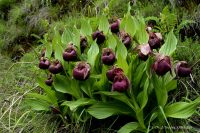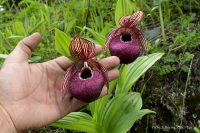|
Cypripedium cordigerum D.Don (N. Pakistan to Himalaya and S. Tibet: East Himalaya, Nepal, Pakistan, Tibet, West Himalaya as per POWO) Cypripedium elegans Rchb.f. (E. Nepal to China (NW. Yunnan): China South-Central, East Himalaya, Nepal, Tibet, West Himalaya as per POWO) Cypripedium himalaicum Rolfe (Himalaya to S. & SE. Tibet and N. Myanmar: East Himalaya, Myanmar, Nepal, Tibet, West Himalaya as per POWO) Cypripedium tibeticum King ex Rolfe (Sikkim to Central China and N. Myanmar: China North-Central, China South-Central, East Himalaya, Myanmar, Tibet as per POWO) . Lady’s slipper orchids: Lady’s slipper orchids, lady slipper orchids or slipper orchids are the orchids in the subfamily Cypripedioidea, which includes the genera Cypripedium, Mexipedium, Paphiopedilum, Phragmipedium and Selenipedium. They are characterised by the slipper-shaped pouches (modified labellums) of the flowers – the pouch traps insects so they are forced to climb up past the staminode, behind which they collect or deposit pollinia, thus fertilising the flower. This subfamily has been considered by some to be a family Cypripediaceae, separate from the Orchidaceae. The subfamily Cypripedioideae is monophyletic and consists of five genera. Their common features are two fertile diandrous (that is, with two perfect stamens) anthers, a shield-shaped staminode and a saccate (sac-shaped) lip.
The Cypripedium genus is found across much of North America, as well as in parts of Europe and Asia. The state flower of Minnesota is the Showy Lady’s Slipper (Cypripedium reginae). The Lady’s Slipper is also
the official provincial flower of Prince Edward Island, a province of Canada. Paphiopedilums are found in the tropical forests of southeast Asia reaching as far north as southern China. Paphiopedilum is quite easy to cultivate and therefore is popular among orchid enthusiasts. In fact, overcollecting of this genus has caused some problems in its original habitat.
Phragmipedium, found across northern South and Central America, is also easy to cultivate as it requires lower temperatures than Paphiopedilum, eliminating the need for a greenhouse in many areas. The lady’s slipper is also known in the United States of America as the moccasin flower, from its resemblance to a shoe or moccasin. The once thought extinct flower is now legally protected from cultivation. This variety of orchid was spotted at a a golf course in Lancashire England and daily patrols are made to ensure its safety.
Above’s source: WIKIPEDIA
INDIA
In India the subfamily is represented by two genera, namely, Cypripedium and Paphiopedilum, which inturn are represented by 5 (C. elegans, C. guttatum, C. cordigerum, C. himalaicum, C. tibeticum) and 9 species (P. charlesworthii, P. insigne, P. druryi, P. villosum, P. fairrieanum, P. spicerianum, P. hirsutissimum, P. venustum, P. wardii) respectively.
Of these only 3 species of Cypripediums are found in Western Himalaya and one species of Paphiopedilum is found in Western Ghats, i.e., Paphiopedilum druryi.
I will be sharing few pics of this subfamily in my next few mails.
. THE LADY SLIPPER ORCHIDS: There are more than one genus in the Lady Slipper Orchids. They are called so because of the structure of the lip or labellum which looks like slippers. Cypripedium Of these only two genus is represented in India namely, Cypripedium represented by 5 species (C. cordigerum, C. elegans, C. guttatum and C. himalaicum) and Pahphiopedilum represented by 9 species (P. charlesworthii, D. druryi, P. farrieanum, P. hirsutissimum, P. insigne, P. spicerianum, P. venustum, P. wardii). To add, all the Paphiopedilums are included under the Wildlife Protection Act (1972) of India in the Schedule VI. Which means they are protected by law and you cant disturb their habitat in wild, you cant pluck them from wild and grow them in your garden etc. glad to hear of the restrictions… . I forgot how to edit these pages. 🙁 POWO,GBIF and CoL showing distribution for Arunachal Pradesh / East Himalayas.
|
Cypripedium
Updated on May 17, 2025




